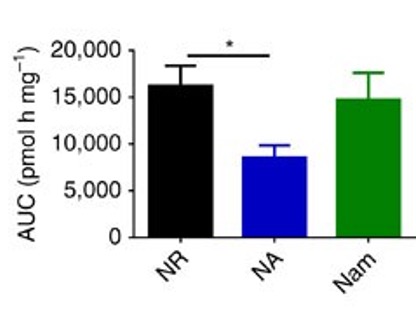Key Points:
- The essential role of vitamin B3 is to maintain adequate NAD+ levels.
- Some forms of vitamin B3 have unique effects that can be positive or negative.
- One study has compared how much each form of vitamin B3 raises NAD+ levels.
There are three naturally occurring forms of vitamin B3:
- Nicotinic acid
- Nicotinamide
- Nicotinamide riboside
In the early 1900s, an epidemic of pellagra spread across the American South, afflicting mostly malnourished farmers. The disease triggered madness and mortality rates as high as 64% within insane asylums. The culprit was vitamin B3 deficiency, leading to the creation of vitamin B3 supplements — the cure for pellagra. The synthetic forms of nicotinic acid and nicotinamide were named niacin and niacinamide, respectively. Nicotinamide riboside wasn’t discovered until later.

Nicotinic acid/niacin (NA), nicotinamide/niacinamide (NAM), and nicotinamide riboside (NR) are NAD+ precursors, which are converted to NAD+ inside of our cells. Thus, the importance of maintaining an adequate intake of vitamin B3 is largely based on maintaining cellular NAD+ levels. In addition to preventing pellagra, scientists have found that maintaining NAD+ levels is associated with delaying the onset of age-related diseases like heart disease, dementia, and cancer. Still, beyond NAD+ metabolism, some forms of vitamin B3 exert unique effects.
Unique Actions of Vitamin B3s
Unlike other forms of vitamin B3, NA triggers flushing of the skin, which is not due to elevating NAD+ levels. The skin flushing reaction appears to be a result of NA binding to a specific receptor on immune cells in the skin. NA also lowers LDL cholesterol while raising HDL cholesterol, unlike NAM and NR. As such, NA is often prescribed to individuals with high cholesterol who can’t take statins. Precisely how NA lowers LDL cholesterol is unclear, but the reason does not seem to be due to raising NAD+ levels.
Compared to NA and NR, NAM uniquely inhibits enzymes called sirtuins. Sirtuins use NAD+ as fuel to exert beneficial effects such as DNA repair that promote cell survival. However, NAM must accumulate to inhibit sirtuins, which could occur if the enzymes that break down NAM are overwhelmed. This may happen if NAD+ degradation is increased, as it is in obese and aged mice. Therefore, NAM supplementation may inhibit sirtuins in obese and older adults, although human studies are needed to confirm this.
Which Form of Vitamin B3 Raises NAD+ Levels the Most?
At least one study has directly compared NR, NA, and NAM. The study showed that NR increased NAD+ levels in the liver more than NA. However, no statistical differences were found between NAM and the other B3 vitamins. More studies will be needed to determine the level to which NAD+ is elevated in other tissues, which depends on specific enzymes. For example, NA is unlikely to raise NAD+ in muscle because muscle lacks the NARPT enzyme.

Ultimately, the magnitude of NAD+ elevations may be inconsequential as long as there is enough NAD+ for cells to operate normally. Maintaining adequate NAD+ levels seems to be the key to preventing various adverse conditions when it comes to NAD+ therapy. For example, low NAD+ levels are associated with age-related bone loss, arthritis, neurodegenerative diseases, and heart disease. Therefore, restoring NAD+ levels may counteract these diseases, potentially leading to a longer life in good health.